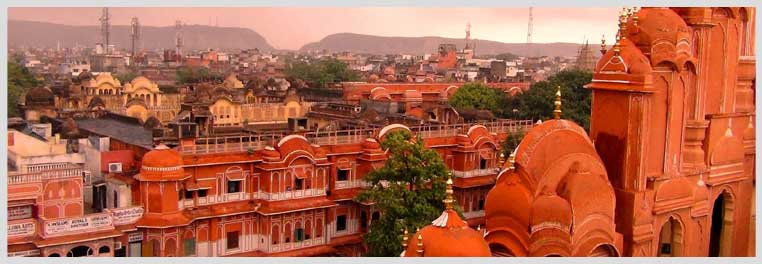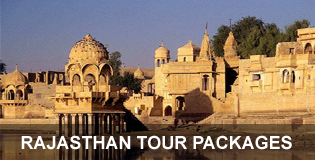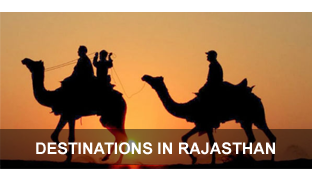Jaipur - The Pink City

This famous city is the capital of the desert state of Rajasthan and has earned universal renown as the Pink City', And pink it is, with beautifully constructed palaces, domes and forts. Tall, rugged men with handlebar whiskers sport bright-pink turbans.. Jaipur which means the city of victory was built in 1727 and is 262 km by road from Delhi. A strong wall encircles the old city and even today has a suggestion of formidable strength, its function of protecting all within is obvious.
The plains of Rajasthan of which Jaipur is the capital once thundered and echoed with the clash of swords and the drums of war.
Built in 1727 by Sawai Jai Singh, Jaipur was the first planned city of its time (the earlier planned city in Northern India having been built near Taxila sometime in the 2nd century BC).
Jaipur was planned by Vidyadhar Bhattacharya, a Bengali archifect, in a grid system with wide straight avenues, roads, streets and lanes and uniform rows of shops on either ide of the main bazars, all arranged in nine rectangular city sectors (chokris). The city itself is an attractive creation worthy of universal admiration.
There is a feast in store for the tourist. Huge and ancient monuments in which one can breathe the fragrance of history, comfortable hotels, once the proud palaces of kings, numerous parks, gardens, and excursions of nearby places of interest, make Jaipur a tourist's paradise.
What to see
The City Palace is a historic landmark. The carved arches are supported by grey-white marble columns studded with floral motifs in gold and coloured stones. The elephants'carved in marble guard the entrance, where retaiers who have served two generations of rulers are at hand to serve as guides.
The palace interior houses a select collection of various types of Rajasthani dresses. The museum contains a fascinating armoury of Rajput weapons; swords of all shapes and sizes, with chased handles, some of them inlaid, enamelled, encrusted with jewels and encased in bold and magnificent scabbards.
The Art Gallery within the museum has a fine collection of astronomical works in Arabic, Persian, Latin and Sanskrit, acquired by Sawai Jai Singh for his study of planets and their movements.
Jantar Mantar is the largest and best preserved of Sawai Jai Singh's five remarkable observatories'. It. is a construction, of stone and marble structure whose setting and shapes are precisely and scientifically designed and which are one of the high-points of medieval Indian astronomy. The two Ram Yantras used for gauging altitudes are unique in their isolation.
The Palace of Winds—a remarkable landmark of Rajasthan. Built by the orders of poet-king, Sawai Pratap Singh, the Hawa Mahal is the most strikingly design ed monument in Jaipur. What is seen from the Sireh Deorhi.. Bazar is the multi-niched five-storey high backside of the complex. It was conceived to provide adequate vantage position behind delicate stone-carved Jali screens to the palace women for watching the royal processions passing through the bazar.
ln the central pavilion of the sprawling Jai Niwas Garden to the north of the Chandra Mahal is the spireless temple of Lord Krishna. The image in the form of Govind Devji, originally installed in a temple of Vrindavan, was reinstalled here by. Sawai Jai Singh as his family deity This is the most famous and popular temple in the Pink City attracting devotees from all over the country.
The tower dominating the skyline on the western side of Tripolia Bazar is the highest structure in Jaipur. It wag built by Sawai Ishwari Singfi in 1749 to commemorate an important victory.
To provide open space and greenery to the citizens, this large garden, with a zoo, an aviary, a greenhouse a herbarium, a museum and several sports grounds, was built during the reign of Sawai Ram Singh II in 1868 as a famine relief project. The beautiful IndoSaracenic structure of the Albert Hall designed by Sir Swinton Jacob was opened in 1 887 as a public museum (open during 1000 to 1700 hrs.). It contains a fine collection of sculptures, paintings, decorative art objects, natural, history specimens, an Egyptian mummy and the celebrated Persian Garden Carpet. Recently, the Rabindra Manch with an auditorium, a modern art gallery and an open-air theatre has, been added to promote cultural activities.
Attractive dolls from various countries are housed in the compound of the school for deaf and mute children, near the Police Memorial.
Equipped with modern computerised projection system, the planetarium offers unique audio-visual educational entertainment. School group concession available. Closed on every last Wednesday of the month.
10 km. Beyond the gardens amidst the low hill guarding the city lies the old pilgrim centre of,Galtaji. Temples, pavilions and holy kunds (natural Springs and reservoirs) dot the serene green landscape. The small temple of the Sun god, built by Diwan' Kriparam on top of the highest peak, is visible from all parts of the city.
The Jain temple on the right side of the Agra Road where it reaches level land has some of the most beautiful paintings of 19th century Jaipur style on its inner walls.
The other important landmarks dotting the southern horizon are the small privately-owned hilltop fort of Moti 000ngari shaped like a Scotish castle, the Ganesh Temple at the foot of the hill 'and the sparkling white marble Lakshmi Narayan Temple built a few years back by Birlas.
The full length white marble statue of Sawai Jai Singh installed in the centre of the Circle in the newly developed 'C' Scheme area, was erected as a homage' to the founder of Jaipur. The latest addition in this area is the BM Birla Planetarium and Science Centre.
8 km. Onthe road to Amer, there are memorials to the queens in the Maharani-ki-Chhatri complex near the Ramgarh road crossing, the island. palace—Jal Mahal built by Sawai Madho Singh as a pleasure spot at the centre of the Man Sagar lake, and the Kanak Vrindavan complex of temples and gardens recently renovated to its pristine glory. To the west of this road, in a narrow valley, is the royal cremation Iground at Gaitore. The cenotaphs of all Jaipur rulers, with the exception of Sawai Ishwari Singh, who was cremated outside the Jai Niwas Garden, were built at this place. The imposing cenotaph of Sawai Jai Singh stands out for its delicate carvings and beautiful shape.
8 km. Along the road to Agra through a narrow gorge in the south-eastern corner of the walled city, several landscaped gardens were constructed by the kings and important courtiers in the 18th and 19th centuries. The largest and the most famous amongst these is a garden built by Sawai Jai 'Singh for his Sisodia queen—the Sisodia Rani-ka-Bagh. It consists of tiered multilevel-gardens with fountains, watercourses and painted pavilions. Amongst others, the best preserved one is Vidyadhar-ka-Bagh, constructed by the planner of the city, Vidyadhar, with shady trees, flowing water, an open pavilion and suites of living rooms.
11 km For seven long centuries before Jaipur was built, Amer served as the capital of the Kachhwaha rulers of the old state of Dhundhar. Very little of the early structures survives now.
The complex of palaces, halls, pavilions, gardens and temples was built by Raja Man Singh, Mirza Raja Jai Singh and Sawai Jai Singh over a period of about two centuries. The palace complex rising from the placid waters of the Maota lake is approached through a steep path, now often traversed by tourists on elephant-back, to Singh Pol and Jaleb Chowk. Two flights of stairs rise from one end to the chowk, one leading to the elegant temple of Shila Mata and other to the palace complex. The image of the Mother Goddess worshipped with reverence by thousands of devotees every day was brought from Jessore in East Bengal (now in Bangladesh) by Raja Man Singh and installed here The front courtyard of the palace complex is dominated by the spectacular pillarred hail of the Diwani-i-Am and the double-storeyed painted gateway Ganesh Pol. Beyond the corridors and galieries on either side of a small elegant Charbagh style-garden are Sukh Niwas to its right and Jai Mandir to its left. The Jai Mandir in the upper floor combines the finest elements of Mughal architecture and interior decoration in a Rajput setting with intricately carved jali screens, delicate mirror-and stucco works and paintéd and carved dadoes. The older and simpler structures at the far end were built by Raja Man Singh in later years of the 16th century. The well-proportioned Mohan Bari or Kesar Kyari in the centre of the Maotha lake and the Dilaram Bagh at its north end provide a spectacular view from the palaces above.
The City of Amer, once a prosperous settlement of nobles, craftsmen and ordinary citizens, is now mostly in ruins. The beautiful carved and painted Jagat Shiromani temple containing the idol of Lord Krishna, popularly associated with the celebrated saint poetess, Mira Bai, the old temple of Narsinghji and the well-made step-well Panna Mina-ki-Baoli still bear witness to its past glory.
The western skyline is dominated by 'the extensive parkotas (walls), watch-towers and gateways of Jaigarh. It is one of the few military structures of mediaeval India preserved almost intact, containing palaces, gardens, open and covered reservoirs, a granary, an armoury, a' well-planned cannon foundry, several temples, a tall tower and a giant mounted cannon—the Jai Ban–.-one of the largest in the world.
15 km. Beyond the hills of Jaigarh stands the fort of Nahargarh like a watchful sentinel guarding Sawai Jai Singh's beautiful capital. Much of the original structures are now in ruins, but the lovely buildings added by Sawai Ram Singh II and Sawai Madho Singh II still survive.
Excursions
16 km on Tonk road. It has beautiful lain temples and important craft industries besides the ruined palace, broken city walls, triple gateways and a neglected Mughal garden. Large and small units of block and screen printers produce some of the finest hand-printed textiles in the country, admired everywhere.
35 kmsouth-west on Ajmer road. The ground level fort is still in good shape. Its attraction is hand-printed cloth industry. The designs are simpler here, the technique less complicated and the colours of more earthy shades.
32 km north-east. It is famous for its huge artificial lake covering an area of about 20 sq. km., created by constructing a high bund amidst tree-covered hills where the citizens throng in a large number for picnic during the rainy season. Boating and fishing facilities are available in the lake. Also accommodation at Jheel Tourist Village. The temple of Jamwa Mata and the ruins of the old fort still remind of its hoary antiquity.
40 km north-west. The old palace renovated and rebuilt provides the most gorgeously decorated and painted xampIes of Rajput haveli architecture. It provides an ideal spot for outing. This palace has been converted into a heritage hotel.
86 km on the Shahpura-Alwar road. It contains the relics and structures of Mauryan, Mughal and Rajput periods. The excavated remains of a circular Buddhist temple, unique in Rajasthan, make it an important historical place. Akbar the great, constructed a mint and his son Jahangir, built a beautiful Mughal garden and a remarkable monument with painted chhatris and walls.
128 km north-east off the Agra road near Bandikui. It is famous for the temple of Harshad Mata built in the 7th-8th century and the stepped Chanda 'Baoli. Two Jain temples were built at a later period.
94 km west. It is famous for the country's largest inland salt lake. It is also known for holy Devayani tank, the palace and the nearby Naliasar.
aaa
12 km off Amer road. One of the settlements of the Meena tribe, it has an imposing fort, a lain temple and a step-well in. a picturesque location.
40 km on Bassi-Lalsot, off Agra road. One of the historic, battles between Jaipur forces and Marathas was fought at Tunga. Commanding a splendid landscape, the' Fort of Madhogarh nestles amidst mango orchards.
| Area : | 64.75 sq.km, Pink City 9.8 sq. km |
| Altitude : | 431 metres |
| Climate Summer: | Max - 40.0CC, Mean Mm - 25.8CC |
| Climate Winter : | Max - 22.0CC, Mean Mm - 8.3C |
| Rainfall : | 64 cm |
| Best Season : | October-February |
| Clothing Summer : | Light Cottons |
| Clothing Winter : | Woollens |
| Languages : | English, Hindi, Rajasthani |
| Local Transport : | Un-metered taxis and auto-rickshaws. Also buses, cycle-rickshaws. The Rajasthan State Roadways operates regular bus service to Amer Palace and round the city. |
Travel Information
Air :There are flight connections to Delhi, Kota, Jodhpur, Udaipur, Aurangabad Bombay and Ahmedabad.
Rail :An excellent connection from Delhi is Shatakdi and the Pink City Express which provide a convenient link of vestibuled, chair-seating rail service. Other connections to Jaipur are from Bikaner, Jodhpur, Udaipur, Ahmedabad, Secunderabad, Agra, Lucknow, Bombay and Calcutta.
Road :A convenient mode of travel of Jaipur is by road, through a network of tourist buses that are reasonably comfortable. Rajasthan Roadways runs excellent regular service of AC and Deluxe Coaches from Delhi (from Bikaner House, Pandara Road and ISBT, Kashmere Gate) Some distances of note are Delhi 259 km, Udaipur 405 km, Jodhpur 336 km, Ahmedabad 657 km.
Jaipur offers myriad shopping bargains. A major gem and jewellery centre, it is famous for Kundan work (enamel work on gold). Also there are woollen carpets, cotton rugs, marble statuary, enamelled wares, brass ware, hand-block printed Sanganeri and Bagru cotton fabrics, exotic blue pottery made from crushed quartz, leather footwear and more.
Premier shopping areas are Rajasthali (Govt. handicrafts shop at Ml Road), Jauhari Bazar, MI Road, Nehru Bazar, Bapu Bazar, Chaupar Stalls. Sundays are usually closed days.
Besides the national festivals, there are celebrations unique to Jaipur. Gangaur festival in March/April, concentrating on women. Elephant polo, in February/ March when the pachyderm is Used for playing holi and polo. Teej, in July, marking the onset of monsoons.
Other Useful Information
0141
Western India Automobile Association, Rajendra Bhawan, F-74, Subhash Marg, C Scheme Tel 74736
Thomas Cook, Jaipur Towers, Ml Road Tel 60801, 60940; Bank of Baroda I.4l Road Tel 72792 (1000 to 1400 hrs); Bank of India Ml Road Tel 373053 0000 to 1400 hrs) Bank of Rajasthan Ml Rpai Tel 364819 (1000 to 1400 hrs); Rajasthan Bank Rambagh Palace Hotel Tel 381416 (0800 to 2000 hrs); State Bank of India Near Statue Circle, New Revenue Building Tel 380515 0000. to 1400 hrs) State Bank of Bikaner & Jaipur SMS Highway Tel 60415 (1000 to 1400 hrs) State Bank of Bikaner & Jaipur (Evening Branch) Ml Road Tel 370648 (1 40 to 1800 hrs); State Bank of India Ml Road Tel 56320 (1 000 to 1400 hrs) (1430 to 1630 hrs); United Commercial Bank Ml Road Tel 565879 (1430 to 1630 hrs)
GPO, Ml Road Tel 74000; City Post Office, Outside anganeri Gate Tel 560699; RMS Railway Station, .Jaipur.
Tak Studio, SMS Highway; Jaipur Photo Studio, Johari Bazaar; Bengal Photo Studio, Johari Bazaar; NanakRám, Chandpol Bazaar; Spotlite, Nehru Bazaar; Pictorials, Ml Road; Klikks, Nehru Bazaar; Amer Photos, Station Road; Moon lite Studio, Khutetonwalon Ka Rasta, Kishanpol Bazaar; Photo Eye, Near Ajmeri Gate, Kishan Pole.
Approved tourist guides for local sighseeing may be hired through the Tourist Officer, Tourist Information Bureau, Jaipur Railway Station (Tel 31 5714) or the Government of India Tourist Office, State Hotel (Tel 372200).
The sighseeing tours are conducted by Rajasthan Tourism Development Corporation Tourist Hotel Tel 375466; Ashok Travels & Tours, State Hotel, Khasa Kothi Tel 368461; Bajrang Yatra Co. Ajmeri Gate Tel 69885; Kalra Bus Service, Ajmeri Gate Tel 373484; Rathore Transport Service, Dhuleshwar Garden Tel 375451; Trans India, Raja Park Tel 61544.
Sports & Entertainment
Temporary membership available at the Ashok Club, Bhagwan Das Road Tel 381690 and Jai Club, Ashoka Marg Tel 72321. Other clubs are Jaipur Club, Polo Grtiund Tel 72249, Lion's Club and Rotary Club.
Golfers can tee off at the Rajasthan Golf Club, Rambagh.
Apart from horse polo, you can watch and play polo on elephant or camel-back or on a bicycle. The prestigious Rajasthan Polo Club in Jaipur has many distinguished polo players as its members. Spring (March) marks the polo season in Jaipur when five polo tournaments are held—Sawai Madho Singh Gold Vase, Kota Cup, Sirmur Cup, Mysore Cup and Argentine Cup.






